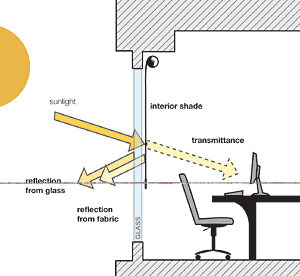Daylight in the Office Space
The Art of Daylighting
Daylighting is defined as the proper utilization of daylight to reduce energy consumption in the interior of buildings, while reducing sun glare and protecting the visual ergonomics of the space. Daylighting employs a regulated balance of electric and natural light in conjunction with the other building systems, finishes, fabrics, and furnishings that combine to make up the building's interior. To maximize the benefits of daylighting, daylight should be controlled.
|
||||||||||||||
A variety of technologies have been developed to control daylight, including, but not limited to, horizontal louvers, vertical blinds, draperies, and roller shades. These control devices range in price, flexibility, and ability to effectively manage light, minimize glare, preserve outdoor views, allow for privacy, reduce UV radiation, combat solar heat gains, and enhance "curb appeal" and property value by offering the opportunity for a more consistent façade appearance.
Horizontal Louvers (Mini-Blinds)
Horizontal louvers equip office windows with a "lift and tilt" system capable of partially or completely deflecting glare-causing light and repelling solar heat. Horizontal louvers can be positioned to direct available daylight more deeply into the space. When tilted closed, this barrier to light and heat also provides excellent privacy to building occupants, allowing zero view to outsiders looking in. Unfortunately, with manual louvers tilted to block solar heat, UV rays, and direct light, the view to the outside is almost completely compromised. Lifting or opening the louvers in order to see outside renders the apparatus nearly useless in terms of daylight management, exposing the interior to unfiltered solar energy.










